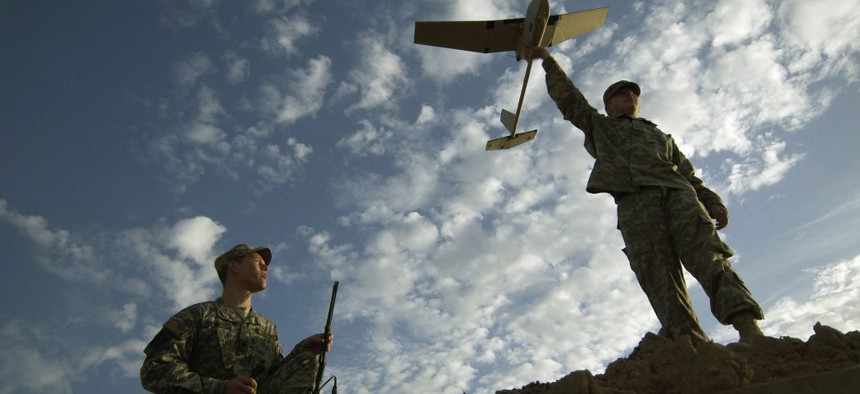
Army wants drones to act as scouts for ground vehicles
The service is asking for demonstrations of short-distance, low-altitude autonomous UAS navigation.
The Army is looking to develop an autonomous unmanned aerial system that can act as a kind of scout for ground vehicles, following the road in front of the vehicle at a fairly low altitude while matching the vehicle’s speed, with the ability for ground crew to manually override the UAS controls when necessary.
It’s still in the early stages, but in a sources sought notice issued this month, the Army said it is seeking white papers as well as capability demonstrations for an autonomous UAS navigation requirement. Such a system should be capable of demonstrating some or all six capabilities listed in the notice:
- Fly a UAS ranging from stationary up to a ground speed of 7 miles per hour in advance of vehicle.
- Fly at an altitude of nine to 98 feet and maintain a variable distance of zero to 196 feet in advance of a supporting ground vehicle.
- Match the speed of a ground vehicle once positioned in advance of it.
- Allow for manual override for investigating targets of interest whether the ground vehicles if moving or stationary.
- Enable adjustments in speed, altitude and distance of the UAS in advance of a moving or stationary vehicle.
- Be capable of following a road in advance of a vehicle moving over complex routes.
Interested responders must be prepared to demonstrate aforementioned capabilities and issue a final report describing technical approaches used during demonstration. The demonstration will either take place at a vendor’s location or Quantico Marine Base between May 2016 and through September 2016.
The Army has invested significantly in UAS technologies in the past few years. A report issued by Govini recently discovered the Army, at its peak in 2012, represented 42 percent of the market procurement, with 200 RQ-7 Shadow purchases. Additionally, Army UAS contracts were the most lucrative among the service branches, with $2.1 million being the average deal size.
The Army has also examined UAS operation in so-called GPS-degraded environments. “As GPS degraded environments become realized, the Gemini lab is on the forefront of understanding these threats and developing strategies to mitigate them,” Virginia Overstreet, Army Aviation and Missile Research, Development and Engineering Center’s Navigation Technology Function chief, said, referring to a laboratory established to “test, evaluate and overcome vulnerabilities of the MQ-1C Gray Eagle system.” In addition to the internal research being done, the Army in October of 2015 issued a sources sought notice seeking the insight of industry to address this very issue. Ultimately, the program wants to expand the capabilities of GPS sensing and collaborating architectures in degraded environments. The service, however, has declined to offer additional details regarding this effort when prodded given the sensitive nature of the material.
Responses for the autonomous UAS navigation requirement notice is due May 19, 2016.